Aspen University N493: Determinants of Health Presentation Analysis
VerifiedAdded on 2022/12/26
|9
|1082
|45
Presentation
AI Summary
This presentation examines the determinants of health among the elderly, focusing on how various factors influence their well-being. The presentation covers 12 core determinants, including gender, health services, employment, education, physical environment, social support, personal health practices, social environments, healthy child development, biology, culture, and financial status. The target audience is hematologic cancer patients who smoke, with a discussion on how low socioeconomic status, lower education levels, and unemployment impact their health. The presentation highlights the importance of these determinants in understanding health outcomes and health disparities within the elderly population. References from sources like the WHO, and various journals are used to support the analysis.
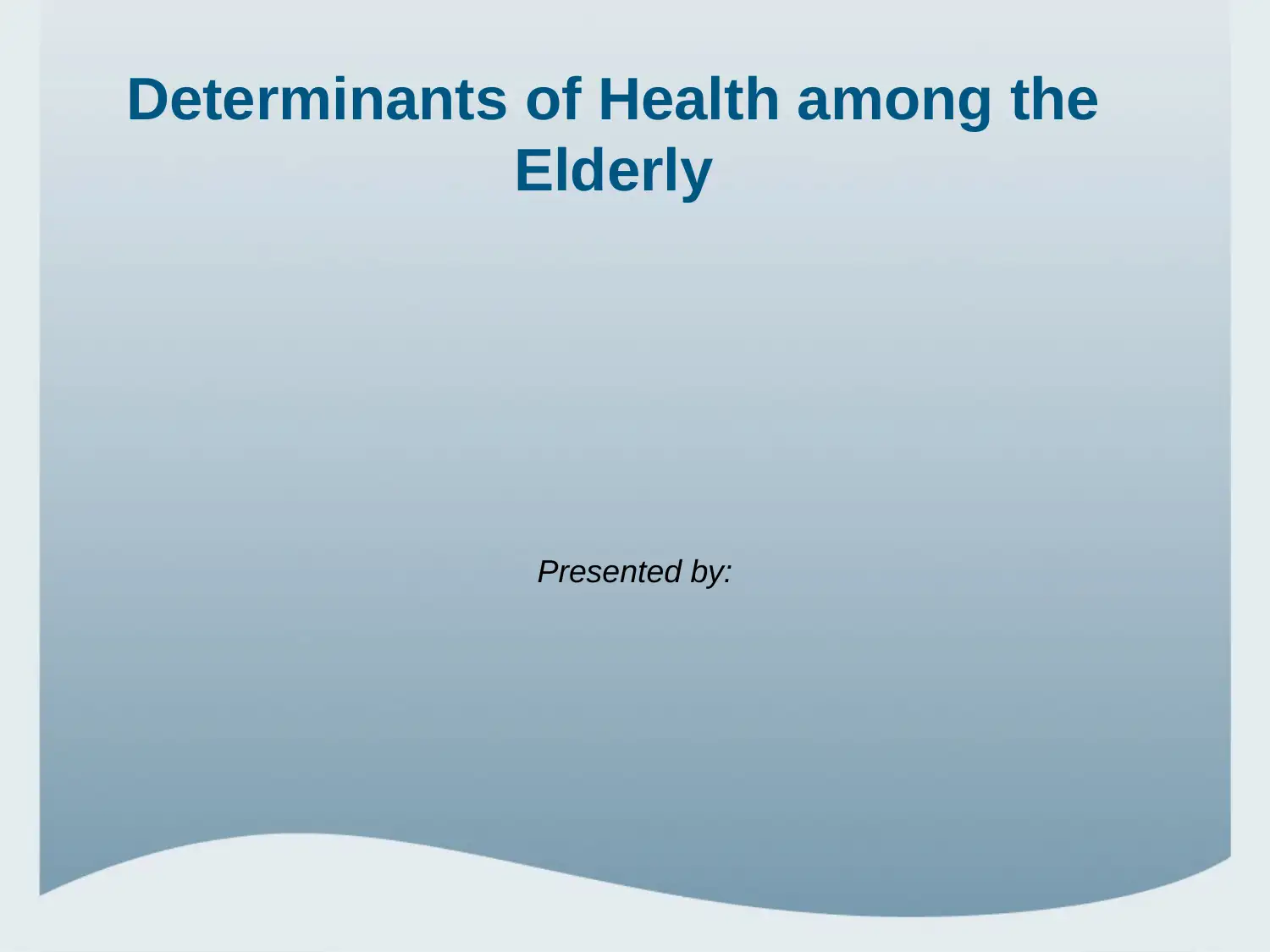
Determinants of Health among the
Elderly
Presented by:
Elderly
Presented by:
Paraphrase This Document
Need a fresh take? Get an instant paraphrase of this document with our AI Paraphraser

PAGE 2
Determinants of Health among the
Elderly
1. Gender
2. Health services
3. Employment
4. Education & literacy
5. Physical environment
6. Social support networks
7. Personal health practices & coping skills
8. Social environments
9. Healthy child development
10. Biology and genetic endowment
11. Culture
12. Financial and social status
Determinants of Health among the
Elderly
1. Gender
2. Health services
3. Employment
4. Education & literacy
5. Physical environment
6. Social support networks
7. Personal health practices & coping skills
8. Social environments
9. Healthy child development
10. Biology and genetic endowment
11. Culture
12. Financial and social status
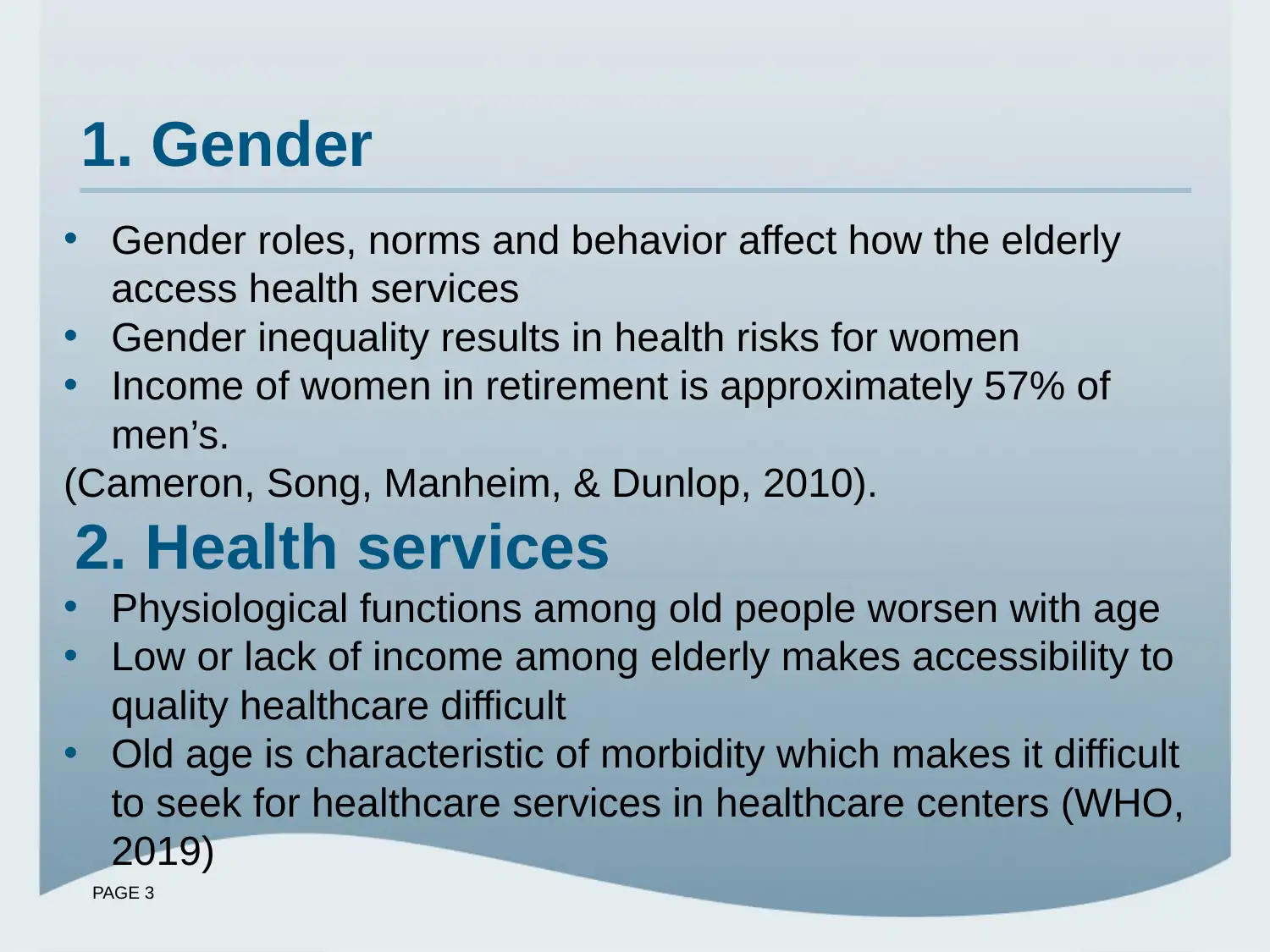
PAGE 3
1. Gender
• Gender roles, norms and behavior affect how the elderly
access health services
• Gender inequality results in health risks for women
• Income of women in retirement is approximately 57% of
men’s.
(Cameron, Song, Manheim, & Dunlop, 2010).
2. Health services
• Physiological functions among old people worsen with age
• Low or lack of income among elderly makes accessibility to
quality healthcare difficult
• Old age is characteristic of morbidity which makes it difficult
to seek for healthcare services in healthcare centers (WHO,
2019)
1. Gender
• Gender roles, norms and behavior affect how the elderly
access health services
• Gender inequality results in health risks for women
• Income of women in retirement is approximately 57% of
men’s.
(Cameron, Song, Manheim, & Dunlop, 2010).
2. Health services
• Physiological functions among old people worsen with age
• Low or lack of income among elderly makes accessibility to
quality healthcare difficult
• Old age is characteristic of morbidity which makes it difficult
to seek for healthcare services in healthcare centers (WHO,
2019)
⊘ This is a preview!⊘
Do you want full access?
Subscribe today to unlock all pages.

Trusted by 1+ million students worldwide
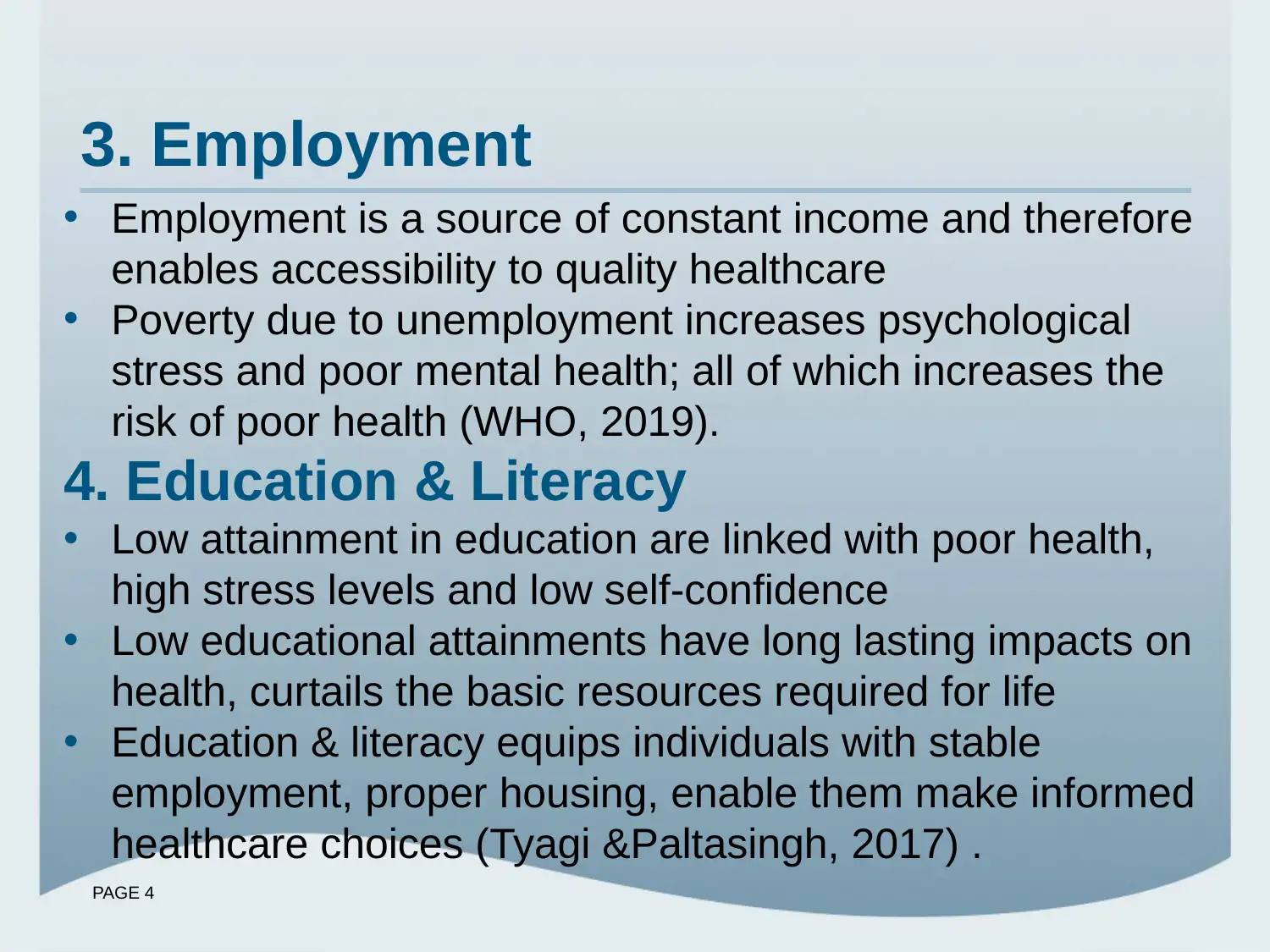
PAGE 4
3. Employment
• Employment is a source of constant income and therefore
enables accessibility to quality healthcare
• Poverty due to unemployment increases psychological
stress and poor mental health; all of which increases the
risk of poor health (WHO, 2019).
4. Education & Literacy
• Low attainment in education are linked with poor health,
high stress levels and low self-confidence
• Low educational attainments have long lasting impacts on
health, curtails the basic resources required for life
• Education & literacy equips individuals with stable
employment, proper housing, enable them make informed
healthcare choices (Tyagi &Paltasingh, 2017) .
3. Employment
• Employment is a source of constant income and therefore
enables accessibility to quality healthcare
• Poverty due to unemployment increases psychological
stress and poor mental health; all of which increases the
risk of poor health (WHO, 2019).
4. Education & Literacy
• Low attainment in education are linked with poor health,
high stress levels and low self-confidence
• Low educational attainments have long lasting impacts on
health, curtails the basic resources required for life
• Education & literacy equips individuals with stable
employment, proper housing, enable them make informed
healthcare choices (Tyagi &Paltasingh, 2017) .
Paraphrase This Document
Need a fresh take? Get an instant paraphrase of this document with our AI Paraphraser
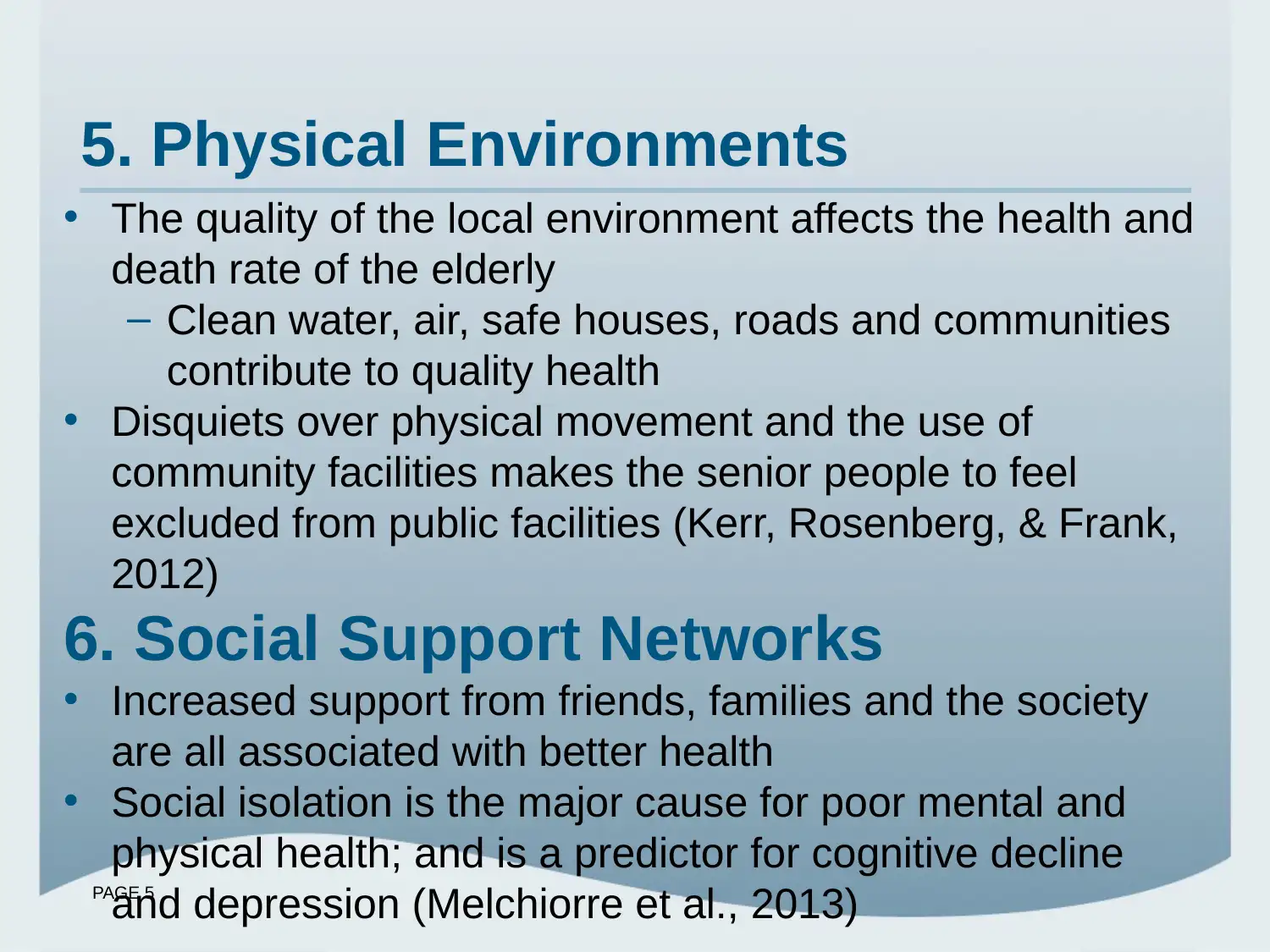
PAGE 5
5. Physical Environments
• The quality of the local environment affects the health and
death rate of the elderly
– Clean water, air, safe houses, roads and communities
contribute to quality health
• Disquiets over physical movement and the use of
community facilities makes the senior people to feel
excluded from public facilities (Kerr, Rosenberg, & Frank,
2012)
6. Social Support Networks
• Increased support from friends, families and the society
are all associated with better health
• Social isolation is the major cause for poor mental and
physical health; and is a predictor for cognitive decline
and depression (Melchiorre et al., 2013)
5. Physical Environments
• The quality of the local environment affects the health and
death rate of the elderly
– Clean water, air, safe houses, roads and communities
contribute to quality health
• Disquiets over physical movement and the use of
community facilities makes the senior people to feel
excluded from public facilities (Kerr, Rosenberg, & Frank,
2012)
6. Social Support Networks
• Increased support from friends, families and the society
are all associated with better health
• Social isolation is the major cause for poor mental and
physical health; and is a predictor for cognitive decline
and depression (Melchiorre et al., 2013)
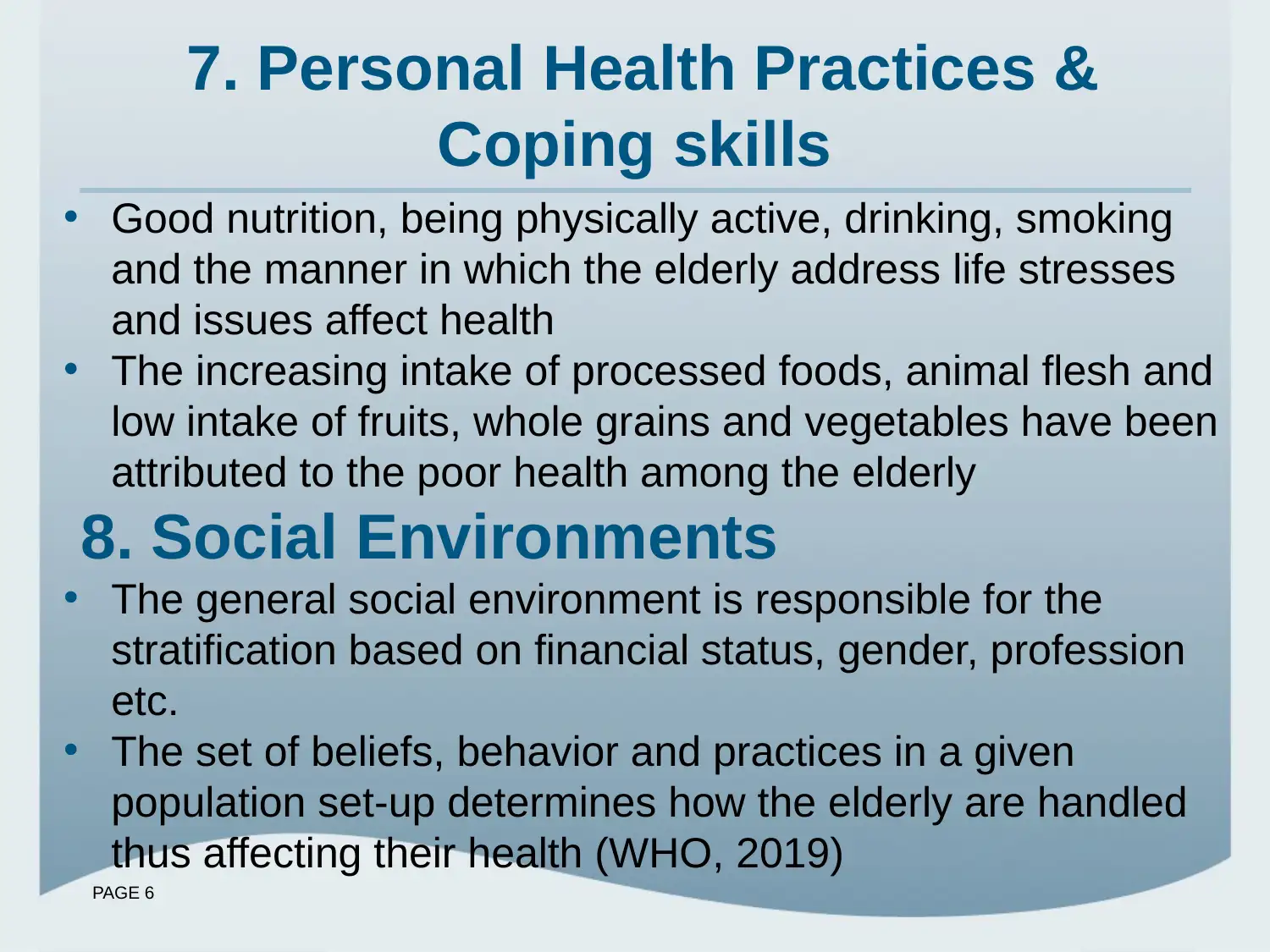
PAGE 6
7. Personal Health Practices &
Coping skills
• Good nutrition, being physically active, drinking, smoking
and the manner in which the elderly address life stresses
and issues affect health
• The increasing intake of processed foods, animal flesh and
low intake of fruits, whole grains and vegetables have been
attributed to the poor health among the elderly
8. Social Environments
• The general social environment is responsible for the
stratification based on financial status, gender, profession
etc.
• The set of beliefs, behavior and practices in a given
population set-up determines how the elderly are handled
thus affecting their health (WHO, 2019)
7. Personal Health Practices &
Coping skills
• Good nutrition, being physically active, drinking, smoking
and the manner in which the elderly address life stresses
and issues affect health
• The increasing intake of processed foods, animal flesh and
low intake of fruits, whole grains and vegetables have been
attributed to the poor health among the elderly
8. Social Environments
• The general social environment is responsible for the
stratification based on financial status, gender, profession
etc.
• The set of beliefs, behavior and practices in a given
population set-up determines how the elderly are handled
thus affecting their health (WHO, 2019)
⊘ This is a preview!⊘
Do you want full access?
Subscribe today to unlock all pages.

Trusted by 1+ million students worldwide
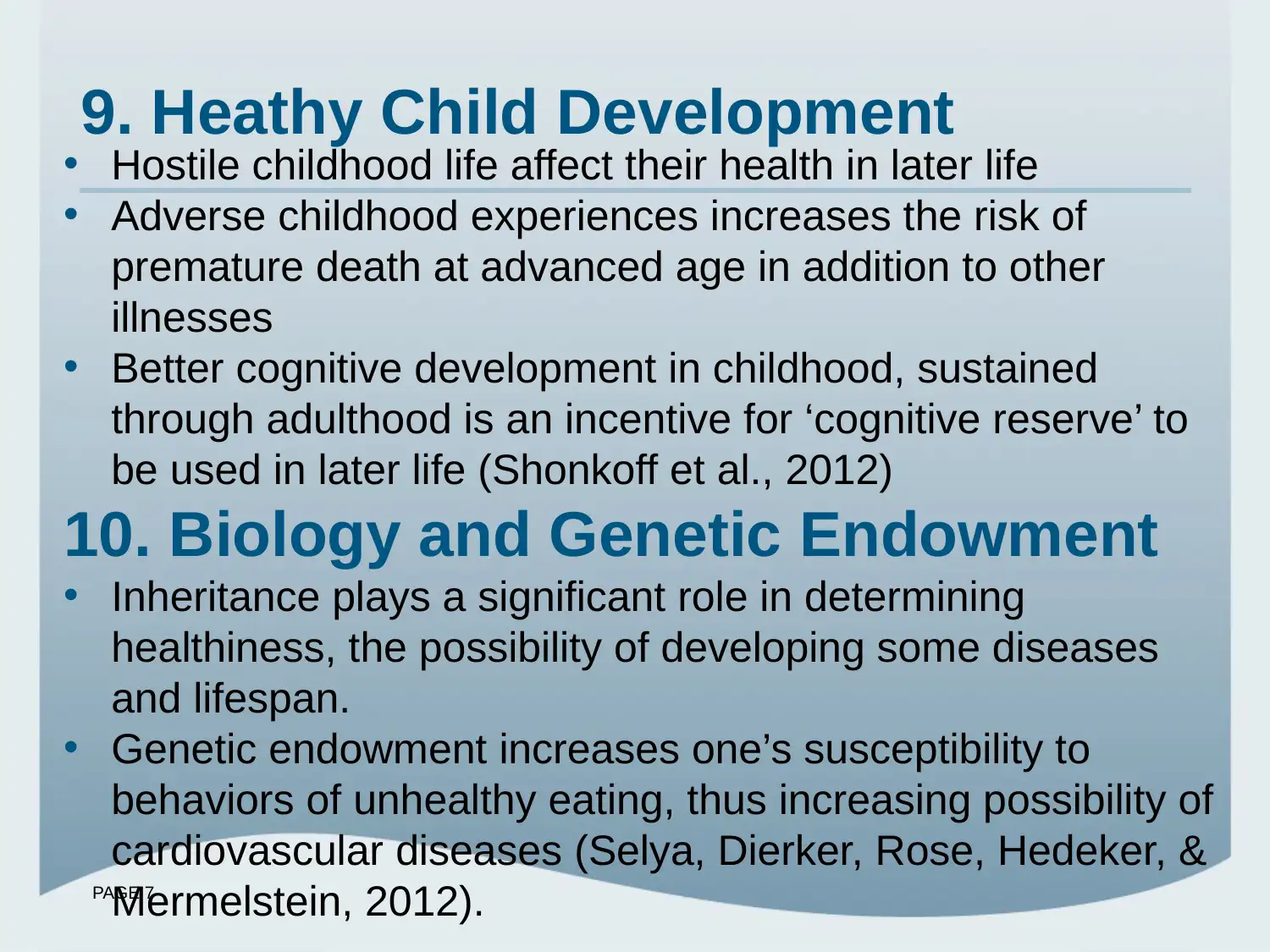
PAGE 7
9. Heathy Child Development
• Hostile childhood life affect their health in later life
• Adverse childhood experiences increases the risk of
premature death at advanced age in addition to other
illnesses
• Better cognitive development in childhood, sustained
through adulthood is an incentive for ‘cognitive reserve’ to
be used in later life (Shonkoff et al., 2012)
10. Biology and Genetic Endowment
• Inheritance plays a significant role in determining
healthiness, the possibility of developing some diseases
and lifespan.
• Genetic endowment increases one’s susceptibility to
behaviors of unhealthy eating, thus increasing possibility of
cardiovascular diseases (Selya, Dierker, Rose, Hedeker, &
Mermelstein, 2012).
9. Heathy Child Development
• Hostile childhood life affect their health in later life
• Adverse childhood experiences increases the risk of
premature death at advanced age in addition to other
illnesses
• Better cognitive development in childhood, sustained
through adulthood is an incentive for ‘cognitive reserve’ to
be used in later life (Shonkoff et al., 2012)
10. Biology and Genetic Endowment
• Inheritance plays a significant role in determining
healthiness, the possibility of developing some diseases
and lifespan.
• Genetic endowment increases one’s susceptibility to
behaviors of unhealthy eating, thus increasing possibility of
cardiovascular diseases (Selya, Dierker, Rose, Hedeker, &
Mermelstein, 2012).
Paraphrase This Document
Need a fresh take? Get an instant paraphrase of this document with our AI Paraphraser
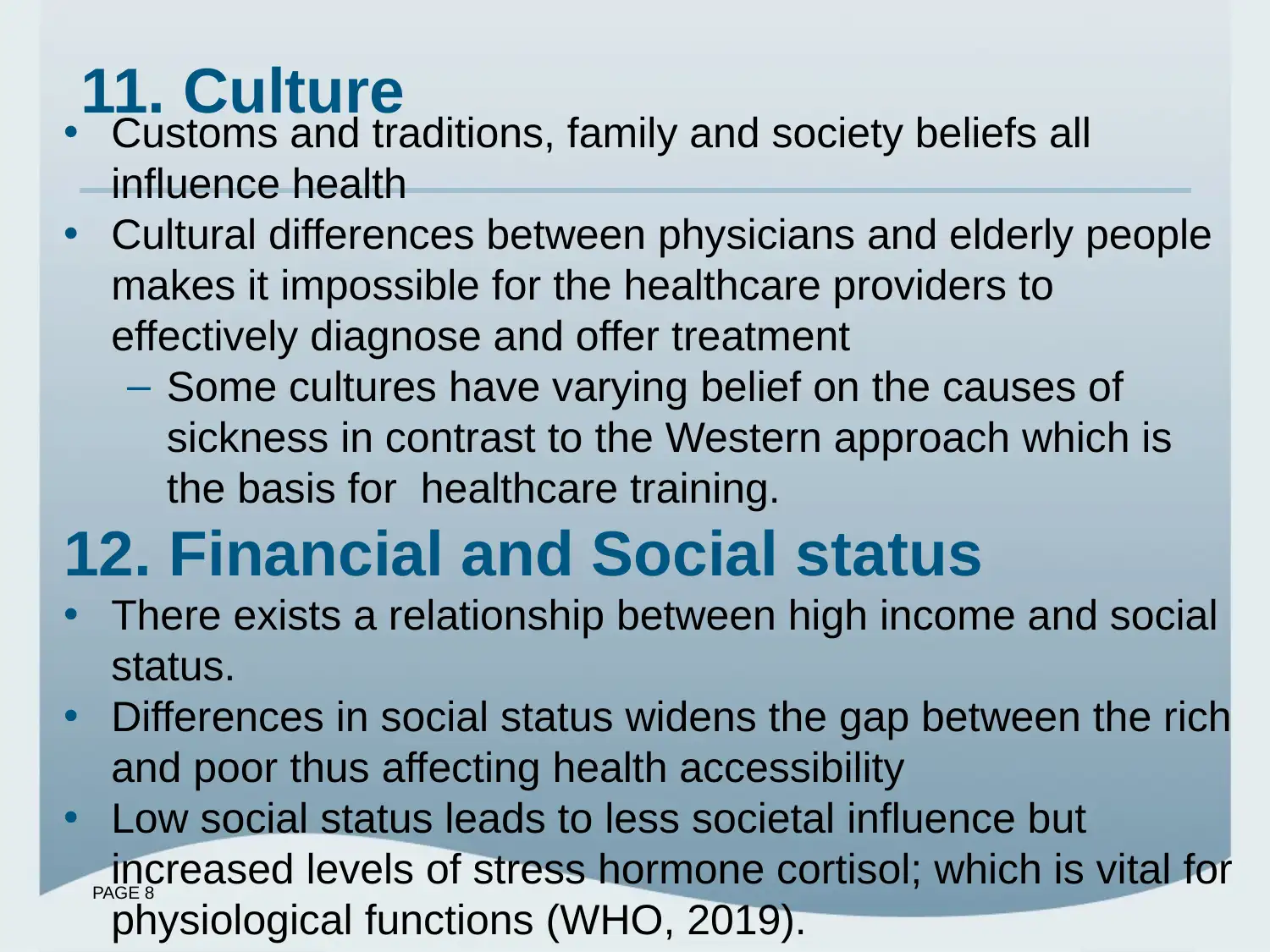
PAGE 8
11. Culture
• Customs and traditions, family and society beliefs all
influence health
• Cultural differences between physicians and elderly people
makes it impossible for the healthcare providers to
effectively diagnose and offer treatment
– Some cultures have varying belief on the causes of
sickness in contrast to the Western approach which is
the basis for healthcare training.
12. Financial and Social status
• There exists a relationship between high income and social
status.
• Differences in social status widens the gap between the rich
and poor thus affecting health accessibility
• Low social status leads to less societal influence but
increased levels of stress hormone cortisol; which is vital for
physiological functions (WHO, 2019).
11. Culture
• Customs and traditions, family and society beliefs all
influence health
• Cultural differences between physicians and elderly people
makes it impossible for the healthcare providers to
effectively diagnose and offer treatment
– Some cultures have varying belief on the causes of
sickness in contrast to the Western approach which is
the basis for healthcare training.
12. Financial and Social status
• There exists a relationship between high income and social
status.
• Differences in social status widens the gap between the rich
and poor thus affecting health accessibility
• Low social status leads to less societal influence but
increased levels of stress hormone cortisol; which is vital for
physiological functions (WHO, 2019).
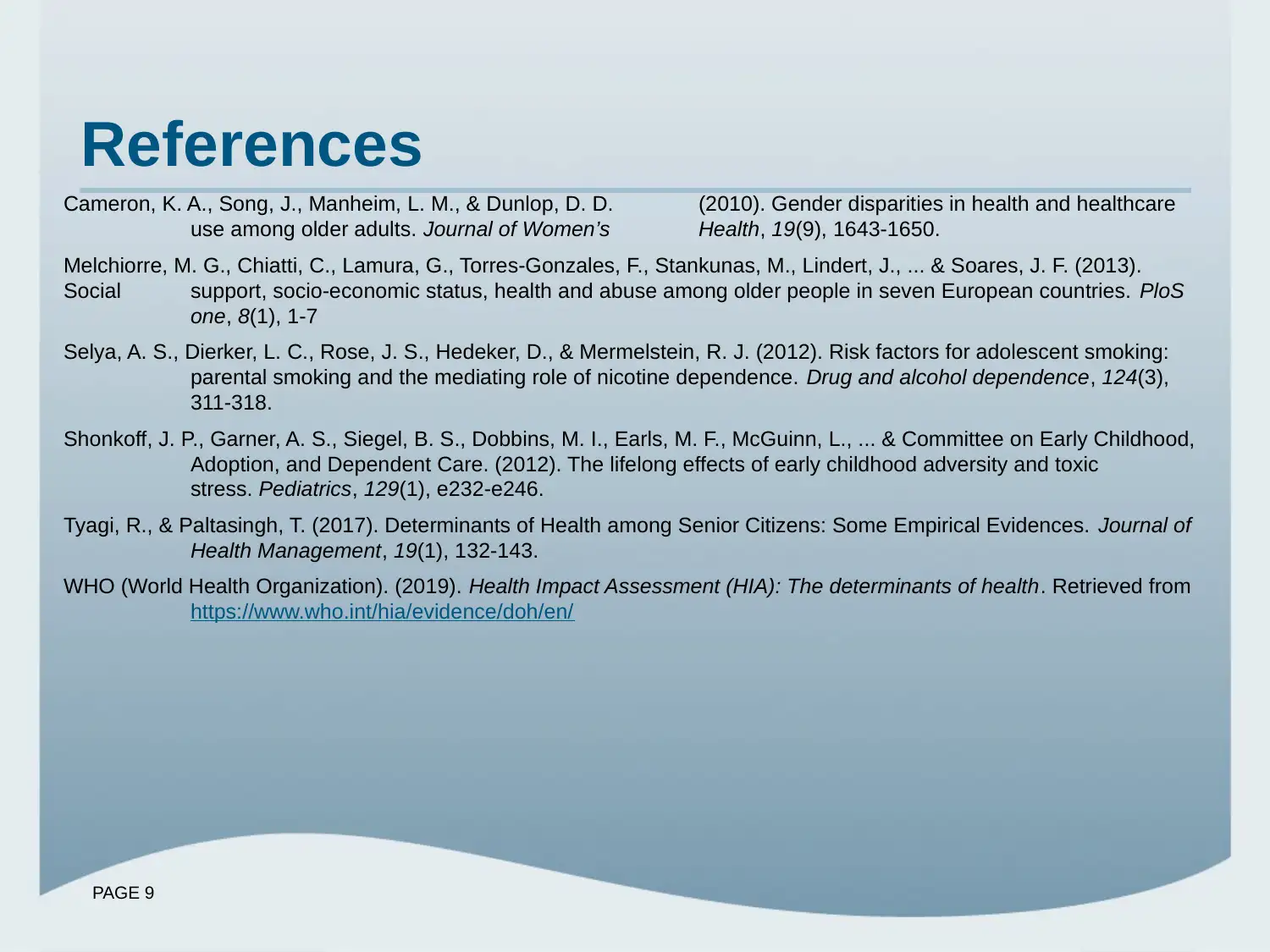
PAGE 9
References
Cameron, K. A., Song, J., Manheim, L. M., & Dunlop, D. D. (2010). Gender disparities in health and healthcare
use among older adults. Journal of Women’s Health, 19(9), 1643-1650.
Melchiorre, M. G., Chiatti, C., Lamura, G., Torres-Gonzales, F., Stankunas, M., Lindert, J., ... & Soares, J. F. (2013).
Social support, socio-economic status, health and abuse among older people in seven European countries. PloS
one, 8(1), 1-7
Selya, A. S., Dierker, L. C., Rose, J. S., Hedeker, D., & Mermelstein, R. J. (2012). Risk factors for adolescent smoking:
parental smoking and the mediating role of nicotine dependence. Drug and alcohol dependence, 124(3),
311-318.
Shonkoff, J. P., Garner, A. S., Siegel, B. S., Dobbins, M. I., Earls, M. F., McGuinn, L., ... & Committee on Early Childhood,
Adoption, and Dependent Care. (2012). The lifelong effects of early childhood adversity and toxic
stress. Pediatrics, 129(1), e232-e246.
Tyagi, R., & Paltasingh, T. (2017). Determinants of Health among Senior Citizens: Some Empirical Evidences. Journal of
Health Management, 19(1), 132-143.
WHO (World Health Organization). (2019). Health Impact Assessment (HIA): The determinants of health. Retrieved from
https://www.who.int/hia/evidence/doh/en/
References
Cameron, K. A., Song, J., Manheim, L. M., & Dunlop, D. D. (2010). Gender disparities in health and healthcare
use among older adults. Journal of Women’s Health, 19(9), 1643-1650.
Melchiorre, M. G., Chiatti, C., Lamura, G., Torres-Gonzales, F., Stankunas, M., Lindert, J., ... & Soares, J. F. (2013).
Social support, socio-economic status, health and abuse among older people in seven European countries. PloS
one, 8(1), 1-7
Selya, A. S., Dierker, L. C., Rose, J. S., Hedeker, D., & Mermelstein, R. J. (2012). Risk factors for adolescent smoking:
parental smoking and the mediating role of nicotine dependence. Drug and alcohol dependence, 124(3),
311-318.
Shonkoff, J. P., Garner, A. S., Siegel, B. S., Dobbins, M. I., Earls, M. F., McGuinn, L., ... & Committee on Early Childhood,
Adoption, and Dependent Care. (2012). The lifelong effects of early childhood adversity and toxic
stress. Pediatrics, 129(1), e232-e246.
Tyagi, R., & Paltasingh, T. (2017). Determinants of Health among Senior Citizens: Some Empirical Evidences. Journal of
Health Management, 19(1), 132-143.
WHO (World Health Organization). (2019). Health Impact Assessment (HIA): The determinants of health. Retrieved from
https://www.who.int/hia/evidence/doh/en/
⊘ This is a preview!⊘
Do you want full access?
Subscribe today to unlock all pages.

Trusted by 1+ million students worldwide
1 out of 9
Related Documents
Your All-in-One AI-Powered Toolkit for Academic Success.
+13062052269
info@desklib.com
Available 24*7 on WhatsApp / Email
![[object Object]](/_next/static/media/star-bottom.7253800d.svg)
Unlock your academic potential
Copyright © 2020–2025 A2Z Services. All Rights Reserved. Developed and managed by ZUCOL.





